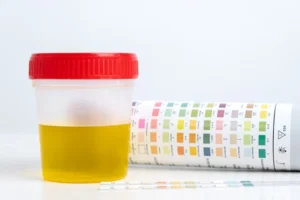The Importance of Chemical Examination of urine
Urine, often considered a waste product, holds a wealth of information about our health. Through a comprehensive chemical examination, healthcare professionals can uncover valuable insights into various bodily functions and detect potential medical conditions.

What is Urine?
Urine is a liquid waste product produced by the kidneys. It consists of water, electrolytes, and various waste substances that are filtered from the blood. The composition of urine can vary depending on factors such as hydration levels, diet, and overall health.
Chemical Components of Urine
Urine analysis involves the examination of several chemical components present in urine. These components include:
- Water: The primary component of urine, accounting for about 95% of its volume.
- Electrolytes: These include sodium, potassium, chloride, and bicarbonate, which help maintain the body’s fluid balance.
- Urea: A waste product formed from the breakdown of proteins. Elevated levels of urea may indicate kidney dysfunction.
- Creatinine: A waste product produced by muscle metabolism. High levels of creatinine can be a sign of impaired kidney function.
- Glucose: Normally, urine does not contain glucose. The presence of glucose in urine may indicate diabetes or other metabolic disorders.
- Proteins: In healthy individuals, urine contains only small amounts of protein. Increased levels of protein in urine may indicate kidney damage or other underlying conditions.
- Acidity/Alkalinity: The pH level of urine can vary, reflecting the body’s acid-base balance.
Chemical Examination Of Urine
Chemical examination of urine consists following examination.
- Bile Salt (Hay’s Sulphure Method)
- Glucoseuria (Benedict Method)
- Ketone Body (Rotheras, Gerhardt’s and Strip Method)
- Proteinuria (Heat and acetic acid, Sulpho Salicylic Acid,Hellers or Nitric acid, and Esbach albuminometer Method)
- Bence Jones Proteinuria (HCl Method)
- Urobilinogen (Ehrlich Method)
- Bile Pigment (Fouchets Method)
- Occult Blood (Orthotoluidine and Benzidine Method).
Also Read:
- Bile Salt (Hay’s Sulphure Method)
“Unlocking the Secrets of Urine: A Comprehensive Guide to Urine Examination”
- Glucoseuria (Benedict Method)
- Ketone Body (Rotheras, Gerhardt’s and Strip Method)
- Proteinuria (Heat and acetic acid, Sulpho Salicylic Acid,Hellers or Nitric acid, and Esbach albuminometer Method)
- Bence Jones Proteinuria (HCl Method)
- Urobilinogen (Ehrlich Method)
- Bile Pigment (Fouchets Method)
- Occult Blood (Orthotoluidine and Benzidine Method).
- Sedimentation Preparation of urine
- Slide Preparation of urine for microscopic
- Microscopic Examination.
- Physical Examination of Urine
Reference books
- “Clinical Chemistry: Techniques, Principles, Correlations” by Michael L. Bishop and Edward P. Fody: This comprehensive text covers various aspects of clinical chemistry, including urinalysis. It’s widely used in medical and clinical laboratory education.
- “Henry’s Clinical Diagnosis and Management by Laboratory Methods” by Richard A. McPherson and Matthew R. Pincus: This is a well-regarded resource that provides insights into laboratory tests, including urinalysis, and their clinical applications.
- “Tietz Textbook of Clinical Chemistry and Molecular Diagnostics” by Nader Rifai, Andrea R. Horvath, and Carl T. Wittwer: This textbook offers a broad view of clinical chemistry, including urinalysis and molecular diagnostics, making it a valuable resource for students and professionals.
- “Urinalysis and Body Fluids” by Susan King Strasinger and Marjorie Schaub Di Lorenzo: This book is specifically focused on urinalysis and the examination of other body fluids. It is used in many medical laboratory technician programs.
- “Urinalysis in Clinical Laboratory Practice” by John A. Lott and W. Gregory Miller: This book provides a detailed look at the theory and practice of urinalysis, making it suitable for those studying or working in clinical laboratories.
- “Urine Analysis: A Color Atlas and Text” by David S. Goldfarb and Alan S. L. Yu: This text combines visual representations with explanatory text to aid in the understanding and interpretation of urine analysis.
- “Pathology Practical Book” by Harsh Mohan: Third Edition.
- Internet, Wikipedia